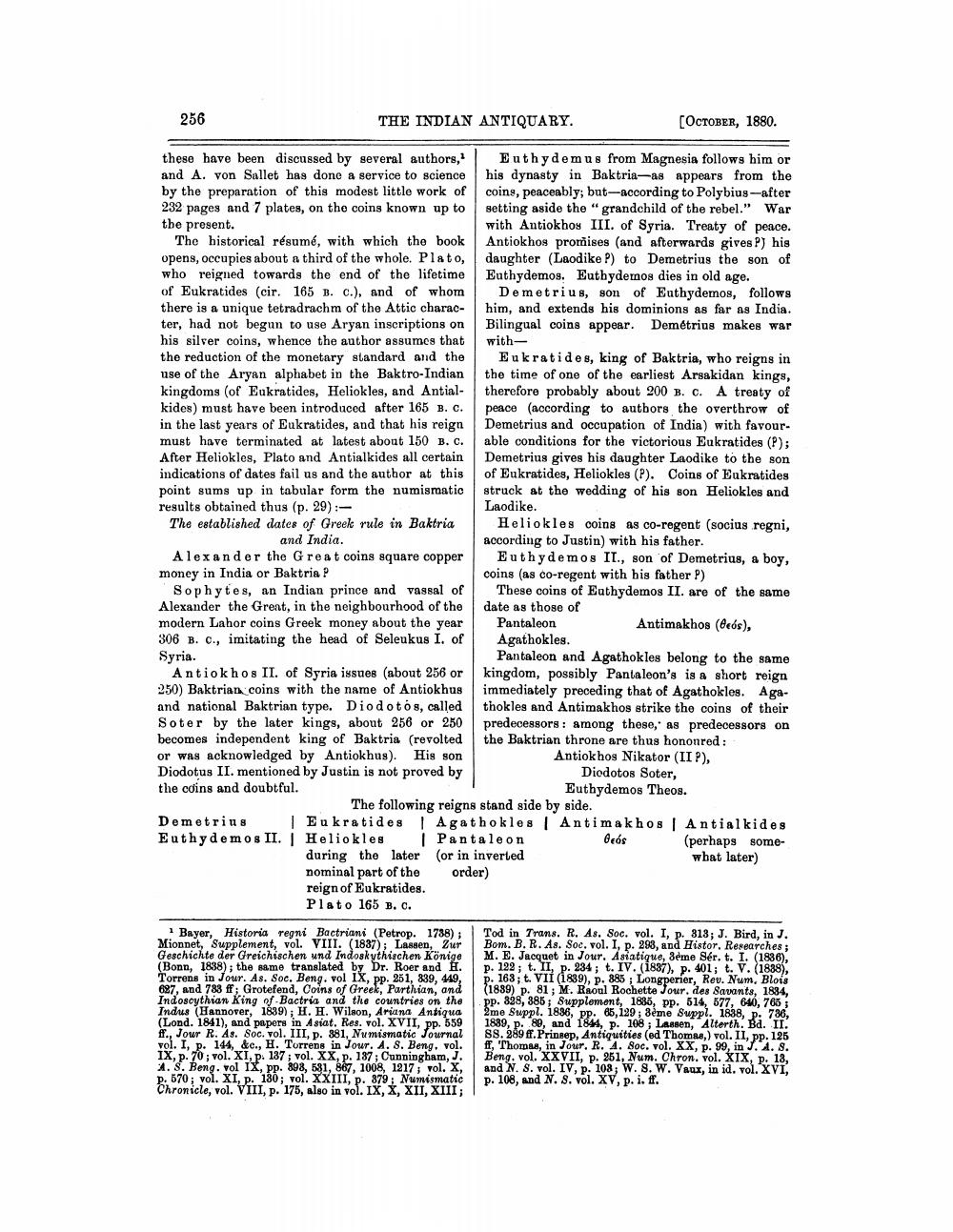________________
256
THE INDIAN ANTIQUARY.
[OCTOBER, 1880.
these have been discussed by several authors, Euthydemus from Magnesia follows him or and A. von Sallet has done a service to science his dynasty in Baktria-as appears from the by the preparation of this modest little work of coins, peaceably; but--according to Polybius-after 232 pages and 7 plates, on the coins known up to setting aside the "grandchild of the rebel." War the present.
with Antiokhoy III. of Syria. Treaty of peace. The historical résumé, with which the book Antiokhos promises (and afterwards gives P) his opens, occupies about a third of the whole. Plato, daughter (Laodike P) to Demetrius the son of who reigned towards the end of the lifetime Euthydemos. Euthydemos dies in old age. of Eukratides (cir. 165 B. c.), and of whom Demetrius, son of Euthydemos, follows there is a unique tetradrachm of the Attic charac- him, and extends his dominions as far as India. ter, had not begun to use Aryan inscriptions on Bilingual coins appear. Demetrius makes war his silver coins, whence the author assumes that withthe reduction of the monetary standard and the Eukratides, king of Baktria, who reigns in use of the Aryan alphabet in the Baktro-Indian the time of one of the earliest Arsakidan kings, kingdoms (of Eukratides, Heliokles, and Antial- therefore probably about 200 B. C. A treaty of kides) must have been introduced after 165 B. C. peace (according to authors the overthrow of in the last years of Eukratides, and that his reign Demetrius and occupation of India) with favourmust have terminated at latest about 150 B. C. able conditions for the victorious Eukratides (P); After Heliokles, Plato and Antialkides all certain Demetrius gives his daughter Laodike to the son indications of dates fail us and the author at this of Eukratides, Heliokles (). Coins of Eukratides point sums up in tabular form the numismatic struck at the wedding of his son Heliokles and results obtained thus (p. 29) :
Laodike The established dates of Greek rule in Baktria Heliokles coins as co-regent (socius regni, and India.
according to Justin) with his father. Alexander the Great coins square copper Euth y demos II., son of Demetrius, a boy, money in India or Baktria P
coins (as co-regent with his father P) Sophytes, an Indian prince and vassal of These coins of Euthydemos II. are of the same Alexander the Great, in the neighbourhood of the date as those of modern Lahor coins Greek money about the year Pantaleon
Antimakhos (bebs), 306 B. C., imitating the head of Seleukus I. of Agathokles. Syria.
Pantaleon and Agathokles belong to the same Antiok hos II. of Syria issues (about 256 or kingdom, possibly Pantaleon's is a short reign 250) Baktrian coins with the name of Antiokhus immediately preceding that of Agathokles. Agaand national Baktrian type. Diodotos, called thokles and Antimakhos strike the coins of their Soter by the later kings, about 256 or 250 predecessors: among these,' as predecessore on becomes independent king of Baktria (revolted the Baktrian throne are thus honoured : or was acknowledged by Antiokhus). His son
Antiok hos Nikator (II?), Diodotus II. mentioned by Justin is not proved by
Diodotos Soter, the coins and doubtful.
Euthydemos Theos. The following reigns stand side by side. Demetrius Eukratides | Agathokles | Antimakhos | Antialkides Euthy demos II. | Heliokles Pantaleon
θεός
(perhaps someduring the later (or in inverted
what later) nominal part of the order) reign of Eukratides. Plato 165 B.C.
Bayer, Historia regni Bactriani (Petrop. 1788) Mionnet, Supplement, vol. VIII. (1837); Lassen, Zur Geschichte der Greichischen und Indoskythischen Könige (Bonn, 1838); the same translated by Dr. Roer and H. Torrens in Jour. As. Soc. Beng. vol IX, pp. 251, 339, 449, 627, and 788 ff, Grotefend, Coins of Greek, Parthian, and Indoscythian King of Bactria and the countries on the Indus (Hannover, 1839); H. H. Wilson, Ariana Antiqua (Lond. 1841), and papers in Asiat. Res. vol. XVII, pp. 559 ff., Jour R. As. Soc. vol. III, p. 881, Numismatic Journal vol. I, p. 144, &c., H. Torrens in Jour. A. 8. Beng. vol. IX, p. 70; vol. XI, p. 137 ; vol. XX, p. 187; Cunningham, J. 1. 8. Beng. vol IX, pp. 893, 581, 887, 1008, 1217; vol. X, p. 570; vol. XI, p. 130; vol. XXIII, p. 379; Numismatic Chronicle, vol. VIII, p. 175, also in vol. IX, X, XII, XIII;
Tod in Trans. R. As. Soc. vol. I, p. 813; J. Bird, in J. Bom. B. R. As. Soc. vol. I, p. 293, and Histor. Researches; M. E. Jacquet in Jour. Asiatique, 3ème Sér. t. I. (1836), p. 122 ; t. II, p. 234; t. IV. (1837), p. 401; t. V. (1838), P. 163; t. VII (1839), p. 885 Longperier, Rev. Num. Blois (1889) p. 81; M.Raoul Rochette Jour des Savants, 1834, pp. 338, 385; Supplement, 1835, pp. 514, 577, 640, 765 2me Suppl. 1836, pp. 85, 129; 8ème Suppl. 1838, p. 736, 1889, p. 80, and 1844, p. 108; Lassen, Alterth. Bd. II. SS. 389 ff. Prinsep, Antiquities (ed Thomae,) vol. II, pp. 125 ff, Thomas, in Jour. R. 1. Soc. vol. XX, p. 99, in 1.4.8. Beng. vol. XXVII, p. 251, Num. Chron. vol. XIX, p. 13, and N. S. vol. IV, p. 108; W. S. W. Vaux, in id. vol. XVI, p. 108, and N. S. vol. XV, p. i.ff.




